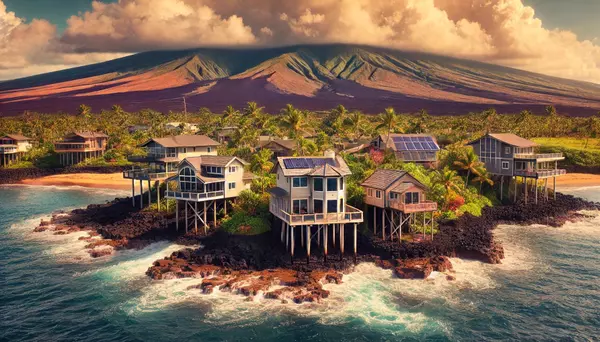
What is HARPTA?
Today, we’re diving deep into a crucial topic that every non-resident buyer and seller of property in Hawaii should know about: HARPTA. Understanding the Hawaii Real Property Tax Act (HARPTA) can save you from surprises at closing, so let’s break it down and make the process a breeze! What is HARPTA? HARPTA, or the Hawaii Real Property Tax Act, isn’t a tax itself but a withholding requirement. Specifically, if you’re a non-resident selling property in Hawaii, the state requires that 7.25% of the sales price be withheld at closing. The purpose? To ensure that any capital gains taxes are paid before you leave with the proceeds. How Does HARPTA Impact Sellers? If you're selling your property and you’re not a Hawaii resident, HARPTA will affect you. It’s essential to note that the withholding is based on the sales price, not just your profit. So, for example, if your property sells for $800,000, $58,000 will be withheld, regardless of how much profit you’ve made. However, the good news is that this withheld amount isn’t gone forever. If your actual capital gains tax is less than the withheld amount, you can apply for a refund! Can You Reduce or Eliminate HARPTA Withholding? Yes, there are ways to reduce or eliminate the withholding before you even file your taxes. Here’s how: Form N-288C: Filing this form can help you get a refund of the withheld amount before you file your tax return. This is particularly useful if the amount withheld exceeds your actual tax liability. Form N-289: If you meet certain conditions, such as having used the property as your primary residence for at least two years before the sale, you may be able to apply for an exemption from HARPTA. What Buyers Need to Know About HARPTA As a buyer, you’re not off the hook! HARPTA directly involves you because you’re responsible for ensuring the withholding is done and sent to the state. This might sound overwhelming, but don’t worry—your title and escrow company typically handles the process for you. However, it’s essential to be aware of HARPTA’s implications, especially if you’re buying from a non-resident seller. If you don’t ensure the withholding happens, you could potentially be on the hook for unpaid taxes. Also, consider the future: If you’re a non-resident buyer now but might become a non-resident seller down the line, HARPTA will come into play when you sell the property. Why Does Hawaii Have HARPTA? HARPTA ensures that the state of Hawaii collects its due taxes from non-residents selling property within the state. It prevents non-resident sellers from avoiding their tax obligations and ensures that the proper amount of capital gains tax is paid to the state. In some cases, this may result in over-withholding, but again, the seller can apply for a refund if the withholding exceeds their tax liability. Final Thoughts on HARPTA: What You Need to Remember HARPTA may seem complex, but with a little knowledge and the right forms, it’s manageable. Whether you're buying or selling in Hawaii, understanding HARPTA is crucial to ensuring that the real estate process goes smoothly and there are no surprises at closing. Take Action: Simplify Your Hawaii Real Estate Experience Whether you’re a non-resident seller looking to understand HARPTA or a buyer navigating the beautiful Big Island real estate market, we're here to help! Contact us today for expert guidance on buying or selling property in Hawaii. We’ll walk you through HARPTA, help you prepare the right forms, and make your real estate journey as smooth as the island breezes. If you have any questions about HARPTA or Hawaii real estate, don’t hesitate to reach out! Leave a comment below, or click here to schedule a consultation with our team. Aloha!

Understanding Lava Zones on the Big Island of Hawaii
Thinking About Buying Property on the Big Island of Hawaii? Here’s What You Need to Know About Lava Zones Are you considering buying property on the Big Island for the first time? Living on an active volcanic island is a truly unique experience, and understanding the lava zones is absolutely crucial. I’m Amber Haley, your local real estate expert, and today I’ll break down what lava zones are and what they mean for you as a real estate buyer. Quick Disclaimer Before we dive in, a quick disclaimer: I’m not a volcanologist. I’m a real estate agent, and while most of the information in this guide comes from trusted sources like the USGS and the Hawaiian Volcano Observatory, I’ll also share my personal experience as a Big Island resident and a homeowner who lived through the massive 2018 eruption. The Big Island's Volcanoes The Big Island is home to five major volcanoes: Kilauea, Mauna Loa, Mauna Kea, Hualalai, and Kohala. Fun fact—Mauna Loa is the largest active volcano on the planet, and Kilauea is one of the most active! While there’s no lava flow right now, that could change at any time, so depending on when you’re reading this, things could be heating up again. Lava Hazard Zones: An Overview According to the USGS, our understanding of volcanic activity is based on written records dating back to the early 1800s, Hawaiian oral traditions, and geological mapping. Using this data, the USGS created a Lava Hazard Zone map in 1974, which was updated in the '80s and '90s. The island is divided into 9 Lava Hazard Zones, with Zone 1 being the highest risk and Zone 9 the lowest. Breakdown of Lava Zones Zones 1 and 2: These are the highest-risk areas, located closest to the volcanic vents of Kilauea and Mauna Loa. Homeowner’s insurance is both costly and hard to come by, and financing is often difficult. Many properties here require cash buyers. Zone 3: This zone includes areas that have experienced lava flows historically but are less frequently affected. Insurance and financing might still be tricky but are generally more manageable than in Zones 1 and 2. Zones 4 to 6: As you move into these zones, the risk of lava flows decreases significantly. Although these areas have had some lava activity in the past, it's much less frequent. Insurance and financing are more straightforward—closer to what you might expect on the mainland. Zones 7 to 9: These zones are considered the lowest risk on the island. They include regions where lava flows are highly unlikely. Homeowners in these zones typically face no issues with insurance or financing. Tips for Real Estate Buyers 1. Do Your Research Before making any purchase, it’s essential to understand the lava zones and the associated risks. Knowing the potential impact on insurance and financing is key. 2. Consult with Experts Talk to local real estate agents (like me!), insurance providers, and maybe even a volcanologist to get detailed insights about the area you're considering. Their expertise can help you make an informed decision. 3. Plan for the Future If you decide to buy in a higher-risk zone, make sure you have an emergency plan in place. Be prepared for potential volcanic activity and familiarize yourself with evacuation routes. 4. Consider All Costs Don’t just focus on the property’s price tag. Take into account additional expenses such as insurance, future evacuations, and other lava-related costs. These can really add up, especially in high-risk zones. Living on an Active Volcano Living on the Big Island means accepting some level of risk from volcanic activity. But with proper research and planning, you can find a stunning property that fits your lifestyle and budget while staying safe. In Conclusion Understanding the lava zones on the Big Island is crucial for any real estate buyer. These zones significantly affect insurance, financing, and, most importantly, the safety of your investment. By doing your homework and consulting with local experts, you can navigate these challenges and still find your dream home in paradise.

Discover the Magic of Buying a Home on the Big Island of Hawaii
Discover the Magic of Buying a Home on the Big Island of Hawaii Relocating to the Big Island of Hawaii is more than just a change of scenery—it's an invitation to experience a vibrant lifestyle, rich culture, and breathtaking natural beauty. Whether you’re dreaming of a cozy beach cottage or a luxurious estate nestled in the hills, the Big Island has something for everyone. This guide is designed to help you navigate the exciting journey of buying a home on the Big Island, ensuring a smooth transition to paradise. Why Choose the Big Island? The Big Island, officially known as Hawaii Island, is the largest and most diverse island in the Hawaiian archipelago. From the lush rainforests of Hilo to the sunny beaches of Kona, the island offers a variety of climates and environments. Here’s why so many people are choosing to make the Big Island their home: 1. Diverse Landscapes: Whether you’re an ocean lover, a mountain enthusiast, or someone who enjoys both, the Big Island offers an unparalleled variety of landscapes. Imagine waking up to the sound of waves in Kailua-Kona or enjoying cool, misty mornings in Waimea. 2. Strong Sense of Community: The Big Island is known for its friendly and welcoming communities. Moving here means becoming part of a close-knit group of locals and fellow transplants who value aloha spirit and a slower pace of life. 3. Adventure at Your Doorstep: If you love outdoor activities, the Big Island is your playground. From snorkeling in crystal-clear waters to hiking up Mauna Kea, there’s no shortage of adventures to be had. What to Consider When Buying on the Big Island Purchasing real estate on the Big Island is unique compared to other markets. Here are some key factors to keep in mind: 1. Climate Zones: The Big Island is home to 11 of the world’s 13 climate zones. This means that weather conditions can vary dramatically across the island. When choosing a location, consider whether you prefer the lush greenery of Hilo’s rainforest or the sunny, dry climate of Kona. 2. Property Types: From traditional Hawaiian homes to modern condos and sprawling estates, the Big Island offers a wide range of property types. Determine what type of property fits your lifestyle and long-term goals. 3.Water Catchment System*: In some areas, especially in more rural parts of the island, properties rely on water catchment systems rather than municipal water. It’s important to understand how these systems work and what maintenance is required. 4. Lava Zones: The Big Island is volcanically active, which affects property insurance and zoning. Be sure to research lava zones and consult with a knowledgeable real estate agent to understand how this impacts your home purchase. Tips for a Successful Big Island Home Purchase 1. Work with a Local Real Estate Expert: A local agent who knows the ins and outs of the Big Island’s real estate market can be your greatest asset. They can provide valuable insights into neighborhoods, property values, and market trends. 2. Visit the Island: If possible, spend some time on the Big Island before making a purchase. This will give you a feel for different areas and help you decide where you’d like to live. 3. Understand Financing: Financing a home on the Big Island can be different from mainland transactions. Work with lenders who are familiar with Hawaiian real estate to ensure a smooth process. 4. Embrace Island Life: Moving to the Big Island is a lifestyle choice. Embrace the slower pace, respect local customs, and immerse yourself in the community to truly enjoy your new home. Final Thoughts Buying a home on the Big Island is more than just a real estate transaction—it’s the beginning of a new adventure. With the right preparation and guidance, you can find your dream home and start living the island life you’ve always wanted. Whether you’re drawn to the island’s natural beauty, its rich culture, or its sense of community, there’s no place quite like the Big Island. Ready to start your journey? Contact me today for expert advice and personalized service tailored to your Big Island home search. Let’s turn your island dream into a reality!
Categories
Recent Posts










